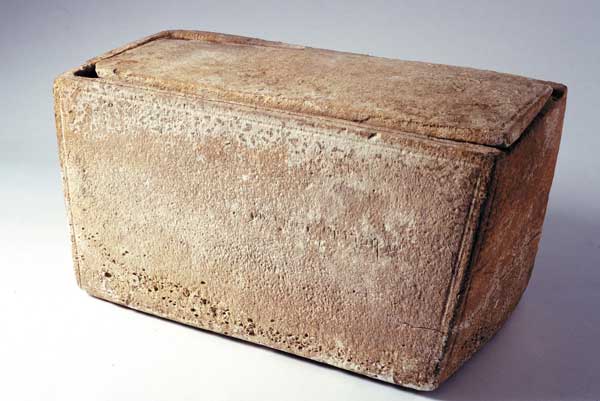Archaeology and faith

The James Ossuary on display at the Royal Ontario Museum from November 15, 2002 to January 5, 2003.
by Stephen Chambers
What does archaeology have to do with faith? That was the big question lurking below the surface in a special evening course Rev. Dr. Steve Chambers taught at Concordia Lutheran Seminary in October and November, 2011. The class was the latest instalment of the long-running Quest series that the seminary offers twice a year, featuring topics aimed at a wide audience.
For a while, archaeology was pretty confident it could dig up proof that the Bible was true. Unfortunately, few excavations produced the desired results, and in some cases, they directly challenged the biblical accounts. A famous example is Jericho, where the work of Kathleen Kenyon and others seemed to contradict the account of the city’s fall in Judges 6.
It’s not surprising then that some Christians consider archaeology rather useless. To them it makes little difference whether you live in first-century Corinth or twenty-first century Calgary, since all people are equally sinful on the one hand, and equally justified on account of Christ on the other (Romans 3:23-24).
Thankfully, a third option has emerged in the last few decades. It resists the naïve hope that archaeology can somehow prove faith, because it recognizes that faith is always a gift of the Holy Spirit, and a matter of trust and belief. At the same time, this third perspective also resists the claim that differences between the biblical world and our own are irrelevant, because it recognizes God works within history not apart from it. The Bible, in other words, grows in meaning when we take its groundedness seriously. Yes, God acted to reconcile all people to Himself through Christ—that’s the universal element of faith, right there. Yet, God chose to send His Son into our world as a first-century Jewish peasant in Palestine—not a twenty-first century, middle-class Canadian.
God chose to send His Son into our world as a first-century Jewish peasant in Palestine—not a twenty-first century, middle-class Canadian.
So how exactly does archaeology help us better understand Jesus’ ministry? As the Quest course showed, this question can be explored in two ways. One can begin with archaeology, as Dr. Chambers did in presenting his personal “top ten” list of artifacts and sites related to the Gospel accounts. Or one can begin with the Gospels, as he did by discussing a number of texts on which archaeology sheds light.
Some Gospel-related artifacts are familiar to many people already. The James Ossuary, for instance, made a big splash when it first became public in 2002. It could very well be the box in which the bones of James, Jesus’ half-brother and the author of the New Testament epistle bearing his name, were buried. Another well-known artifact is the first-century fishing boat that surfaced in 1986 when the water level in the Sea of Galilee dropped dramatically. Its size and construction illustrate the kind of boat that Jesus and His disciples frequently used (Mark 1:20; 4:1, 35).

Sea of Galilee Boat
The most important archaeological site related to Jesus’ ministry is the Church of the Holy Sepulchre. It’s a massive, chaotic, decrepit complex in the heart of Jerusalem’s Old City. Yet, according to many archaeologists, it sprawls directly atop the places where Jesus died, was buried, and rose from the dead. In fact, the only other site that is equally tightly tied to Jesus’ presence is Peter’s house in Capernaum, atop which at least three churches were built between the first and fifth centuries. There’s a very good chance this was the actual home Jesus lived in during the three years of His Galilean ministry (Mark 2:1, 15).
Gospel texts spring to life in new ways too when archaeological insights are taken into account. Jesus’ youthful career as a builder, for instance (Mark 6:2-3), takes fuller shape when we realize that He lived only six kilometres away from the huge new city of Sepphoris that was being built right at that time. Were He and Joseph employed in that project? Later, Jesus centred His ministry on the towns of Capernaum, Chorazin, and Bethsaida (Matthew 11:20-23). Although only a few kilometres apart, archaeology has shown that they differed from each other dramatically in economic activity, religious influences, and even construction materials and methods. Already in the first century, this area was just as diverse and multicultural as many parts of Canada are today!
Of course, none of this really proves anything. It’s unlikely that anybody will become a Christian because of an archaeological site or artifact—though, granted, stranger things have happened. At the same time, it’s hard to see why anyone would dismiss archaeology’s usefulness. Places and objects from first-century Palestine give us a glimpse of the world Jesus lived in, and reinforce the reality of His incarnation. And so: what does archaeology have to do with faith? Plenty!
——————–
Rev. Dr. Stephen Chambers is Associate Professor of New Testament Exegetical Theology at Concordia Lutheran Seminary (Edmonton, Alberta). For the past few years, he has led groups of Canadians to take part in excavations in Hippos, Israel. To take part in 2012’s dig, see the invitation here.




